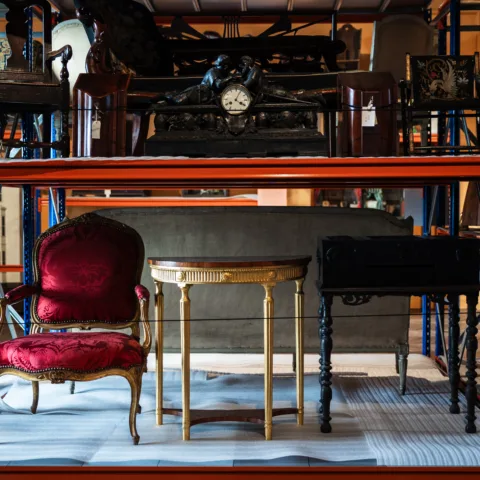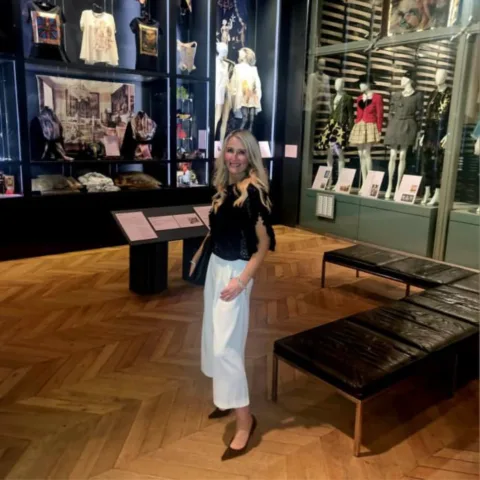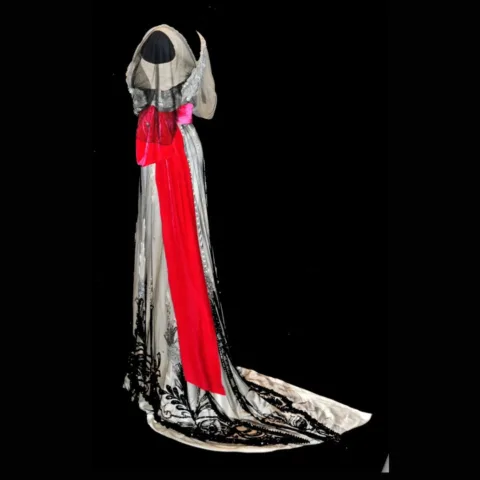The Bowes Museum Blog

Airing Our (Not-So) Dirty Laundry in Public
Each year The Bowes Museum lends objects from its collection to be displayed in exhibitions all over the UK and Europe. Next year the Museum is lending some more unusual objects to go on display at the V&A for their 2016 exhibition ‘Undressed: 350 years of Underwear in Fashion‘.
Once selected by the exhibition curators, the objects come into the museum’s conservation studio for assessment and any conservation treatment that may be needed to stabilise them before they can go out on loan.
Four objects have been selected and needed various levels of conservation treatment:
1: Paper pants This box contains paper pants c.1970, thankfully unused and in their original packaging. They’re an interesting example highlighting the trend for disposable clothing during the 1960s. They did not require any interventive conservation treatment but were assessed and documentation was produced for when they travel.
2: Maternity belt This late 19th century belt or corset in striped cotton twill and a pink brushed cotton lining was designed to be worn during pregnancy. It is believed that at the time women wore these types of belts for added support during pregnancy, having adjustable lacing at the sides and a small amount of boning.Conservation treatment for this object was minimal as it is structurally in very good condition. The belt was surface cleaned, first using a low suction vacuum and then using smoke sponge (a vulcanised rubber dry cleaning sponge) to reduce the all over soiling and insect casings which were present.The thin linen lacing was removed and humidified using contact humidification (a sandwiched layer of semi-permeable fabric, damp blotting paper and polyester film as a protective layer).
The lacing was then re-threaded and the belt was padded with acid-free tissue puffs for temporary storage.
![[Left] CST.2.684 – Showing soiling on surface of cotton lining and a moth casing. [Right] CST.2.684 – The belt lacing following conservation treatment and re-packing.](https://thebowesmuseum.files.wordpress.com/2015/09/3-cst-2-684-e28093-the-belt-lacing-following-conservation-treatment-and-re-packing-cst-2-684-e28093-the-belt-lacing-following-conservation-treatment-and-re-packing.jpg?w=660)
[Left] CST.2.684 – Showing soiling on surface of cotton lining and a moth casing.
[Right] CST.2.684 – The belt lacing following conservation treatment and re-packing.
The belt required more interventive treatment, as the brown sateen outer fabric had become weak and split in several areas, which would have been under strain when worn: around the eyelets, buttons, and top and bottom edges.
The belt was surface cleaned similarly to the maternity belt but using cosmetic sponges which are less abrasive on the fragile fabric, instead of smoke sponge. This was particularly successful on the chamois lining which had an overall layer of grey soiling. Next, fabric was dyed to colour match the brown sateen and patches inserted as support for stitching to strengthen the split areas. Silk crepeline was used to overlay the vulnerable areas on the edges which had split and silk habotai of similar weight to the cotton sateen was used as inserted patches.
Most of the damaged areas were difficult to insert support patches as they were very close to seams. Therefore the decision was made to undo some of the original stitching in order to provide adequate support to the splits. The original thread was carefully unpicked after recording the location of the stitch holes. The patch was stitched into place and then new colour matched thread was used to re-attach the seam following the original stitch holes.
Finally, the ends of the lacings were humidified and the belt was padded with acid-free tissue and put back into storage.

CST.3.385 –1. Images showing surface cleaning of chamois leather lining and the humidification of the linen lacings

CST.3.385 – Before and after treatment of split in cotton. After un-picking of the lower seam, a patch was inserted and couched into place. The seam was then re-stitched and a silk crepeline patch applied to a weak area of cotton to the right
Working women’s pair of stays This pair of stays c.1750 had the most interventive treatment carried out as they were in very poor condition and could not have safely travelled and been put on display in their previous state. (To read more about their provenance of the stays, see this previous blog post).
The decision-making for the treatment of this object was tricky, following discussions with our curator it was felt to be important that the worn and stained appearance was retained as it was integral to the object’s history. Therefore the conservation treatment aim was to stabilise the object, but not alter its appearance greatly.
The treatment began by the removal of modern repairs, which had been added before the object came to The Bowes Museum, as they were unsightly and added little support to the damaged areas.
The stays were then surface-cleaned using a low suction vacuum and smoke sponge. The staining was left untreated.
The remaining treatment consisted of various types of stitched support, including blanket stitching of the fraying tapes on the front of the stays, couched support to the brown cotton areas of loss, inserted patched support of the areas of loss to the linen lining, and net overlays of the damaged edges and padded underarm sections.
Linen was dyed to colour match the different areas of damage to the linen lining, and small silk-covered polyester wadding cushions were inserted to fill the void left by the missing original wool padding. Each patch was couched into place using fine Scala polyester thread. This was the most difficult part of the treatment as the loss was quite extensive in some areas and the patches needed to be lined up with the grain of the fabric while working on a three-dimensional area.

CST.2.976- In progress and after treatment of inserting three patches to infill and support the inner lining
Nylon net was also dyed to colour match the damaged areas, and then stitched into place using Scala thread, to provide a protective barrier layer.
Before being packed away for storage the stays were given a final vacuum, and padded with acid-free tissue puffs and rolls.
Now that the conservation is complete these object will temporarily go back into storage until they are ready to be mounted and packed for transit down to the London for the exhibition. Sadly, I will have finished my one year internship at The Bowes Conservation Department before then, but I will certainly look forward to seeing them on display next year at the V&A!
Emily Austin, Icon/HLF Textile Conservation Intern














